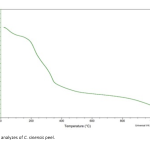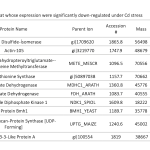| Title | Pages |
|---|---|
| High Throughput Production and Characterization of Primary Rat Hepatocyte Spheroids Developing in vitro models to explore cell biology and physiology holds significant importance in biotechnology, cancer research, drug discovery, toxicity testing, and the emerging fields of tissue engineering and regenerative medicine. The conventional two-dimensional (2D) approaches of mammalian cell culture (2D) have limitations in replicating all of the mechanical and biochemical signals in vivo. Culturing cells as spheroids provides a three-dimensional environment that more accurately mimics physiological conditions compared to 2D culture. In this study, a method for high-throughput spheroid formation using primary rat hepatocytes (PRHs). Using a high throughput platform, the effect of varying concentrations of cell culture media supplements was investigated on spheroid formation. Additionally, different cell seeding densities were assessed and characterized for 7 days. The average diameter and circularity of PRH spheroids remained stable on days 2, 4, and 7, regardless of the initial seeding density. Moreover, PRH spheroids demonstrated high viability (> 90 %) for up to 7 days across all seeding cell densities. These results demonstrated that this technique enables straightforward, large-scale, consistent, and repeatable spheroid manufacturing and presents an alternative approach for future applications. 



|
139 - 146 |
| Crude Oil Biosorption with Citrus sinensis Peels Dried Cydonia oblonga, Persea americana, Malus domestica and Citrus sinensis peels were used as low-cost biosorbents in crude oil removal. Among them, Citrus sinensis was selected as the most effective biosorbent with a removal rate of 83.81% and the effect of adsorption parameters such as pH (4.0-10.0), adsorbent dose (0.1-0.5 g/50mL) and crude oil concentration (0.25-2.5%) were also investigated. Maximum removal rate of 94.37% (qe=1.81) was found at pH=7.0, 0.25 g/50 mL adsorbent dose and 1% crude oil concentration. And 25.91% removal rate (qe=0.49) was determined at the end of the 6th cycle of re-used peels. The kinetics of this adsorption was described by Pseudo-second order model (R2=0.8167) and the equilibrium modelling were well fitted with Langmuir isotherm (R2=0.9403). Characteristic bands of cellulose and hemicellulose in the lignocellulotic structure of dried peels were determined by FTIR. Thermogravimetric profile was resulted as a residual weight of 17.5% even at 1000 ̊C with high resistance to increasing temperature. Therefore,C. sinensis peels, which is a common domestic and an industrial food waste, can be used as a low-cost, easily available, biodegradable and environmentally friendly adsorbent in crude oil removal. 



|
147 - 159 |
| Spleen Toxicity Assessment of Propanil Exposure in Swiss Albino Mice Pesticides or their metabolites may have the capacity to disturb and hinder the functions of some essential organs inc- luding spleen. This study examined the side effects of propanil on the spleen of mice. The experimental groups were exposed to propanil through oral administration for 30 consecutive days. The following histopathological changes were observed in the low-dose group: separation of capsule from the splenic parenchyma, thickening of the capsule, congestion in the splenic parenchyma, dilated sinusoids, arteriolar enlargement, karyolysis in megakaryocytes and amyloid formation. In the medium-dose group, the following changes were detected: hemorrhage and separation in the capsule, amorphous megakaryocytes, karyolysis in megakaryocytes, congestion in the splenic tissue, sinusoidal enlargement, fibrosis, lobule formation, enlargement of the white pulp, deformation of arterioles. The high-dose group showed the following changes: hemorrhage in separated capsule, karyolysis in megakaryocytes, congestion in the splenic parenchyma, enlargement of the white pulp, fibrosis, necrosis in the white pulp, congestion in the enlarged sinusoid and cellular swelling in the splenic red pulp. These results clearly demonstrated that propanil induced important dose-related histopathological damages. Based on our results, we can confidently state that it may have the capacity to cause failure of this organ. 



|
161 - 169 |
| Impact of Meteorological Factors and Air Pollution on Urban Salicaceae Pollen Levels The objective of the research was to examine how meteorological conditions and air pollution affect the levels of Salicaceae pollen in the Ankara province. Salicaceae, a plant family encompassing willows and poplars, generates pollen that may contribute to respiratory allergies. The study employed a Burkard volumetric 7-day spore trap for airborne pollen monitoring throughout the pollen season, spanning from March to June in the year 2023. The relations between pollen concentrations, various meteorological parameters and air pollutants were revealed by correlation and regression analysis. While, the wind direction was found to be positively correlated with Populus pollen concentration, there was also a positive relationship between relative humidity and Salix pollen loads. Additionally, air pollutants, including PM10, PM2.5 and nitrogen oxides, were found be positive impact on the abundance of Populus pollen. Understanding these relationships is crucial for assessing the potential health risks associated with airborne pollen and for developing strategies to mitigate the impact of urban environmental factors on pollen concentration. 



|
171 - 179 |
| Proteomic Analysis of Cadmium Responsive Proteins in Wheat The current study aims to assess the changes in protein abundance in wheat roots upon exposure to cadmium, using a proteomic approach. Wheat seeds were cultivated in a nutrient solution comprised specific macro and micronutrients under controlled environmental conditions and treated with 30 μM Cd for three days. In order to comprehend the impact of Cd stress on the protein level in wheat, a differential proteomics investigation was conducted utilizing two-dimensional polyacrylamide gel electrophoresis (2-DE). Fifty two protein spots were clearly identified and exhibited a consistent and significant alteration between the control and stressed samples. Out of the fifty two proteins, twenty seven exhibited changes in abundance following Cd stress, with seventeen proteins being up-regulated and ten proteins being down-regulated. Differentially regulated proteins were selected after image analysis and identified using MALDI-TOF MS. The identified differential proteins were primarily associated with stress response (41%) and metabolism (35%). These proteins were discovered to play a role in various processes, including protein biosynthesis, carbon metabolism, transportation, and stress response. The findings from our proteomics analysis indicate that Cd stress significantly impacts the stress response in wheat. This study provides novel insights that contribute to an enhanced comprehension of the molecular mechanisms implicated in the plant's reaction to cadmium-induced stress. 


|
181 - 188 |
| Gentamicin Induces Selective Toxicity in Metabolically Altered Vemurafenib-Resistant A375 Cells Rising global cancer incidence and mortality, coupled with the challenge of drug resistance, necessitate novel therapeutic strategies. This study investigates the potential repurposing of gentamicin for treating drug-resistant melanoma by targeting metabolic alterations. Initially, we addressed the influence of antibiotics on mitochondrial function, a crucial player in oxidative phosphorylation (OXPHOS). To assess this impact, we first cultured two different cancer cells, A375 and PC3, in antibiotic-free medium and showed that mitochondrial membrane potential of cells increased in the absence of antibiotics compared to cells cultured in antibiotic containing medium. Next, we developed vemurafenib resistance in A375 cells, which were continuously cultured in antibiotic-free medium. The resistant cells exhibited a marked increase in oxygen consumption rate, indicating a shift towards OXPHOS. Finally, we treated these vemurafenib-resistant cells and noncancerous human fibroblast cells (CCD-1072Sk) with varying concentrations of gentamicin (1-1000 μM). Remarkably, gentamicin showed selective cytotoxicity towards the resistant cells while sparing non-resistant counterparts and noncancerous cells. Our findings highlight gentamicin's potential as a therapeutic agent in targeting the metabolic vulnerabilities of drug-resistant melanoma, presenting a viable new pathway in cancer treatment. 



|
189 - 197 |
| Investigation of Effect of Resin Content on the Stress Relaxation of Poly (epichlorohydrin-co-ethylene oxide) Based Elastomers In this study, the effect of C9/C10 aromatic hydrocarbon resin and resin amount on the curing and stress relaxation properties of poly (epichlorohydrin-co-ethylene oxide) based elastomers was investigated. The curing parameters of elastomers that did not contain resin and elastomers containing resin in different proportions were examined. When examining the curing parameters, it was observed that with increasing resin content, the scorch time (ts2) and optimum curing time (t90) increased, and the curing rate decreased. Moving die rheometer studies showed that as the amount of resin increased, cross-link formation reactions were delayed or negatively affected. Additionally, temperature scanning stress relaxation (TSSR) studies were conducted to evaluate the effect of the resin on the stress relaxation behavior, service temperature, and cross-link density of the prepared vulcanizates. TSSR studies were carried out in two stages: first, after curing and then after removing the resin from the vulcanizates by extracting the test samples in toluene. TSSR data showed that when the resin ratio was above 5 phr, the stress relaxation behavior of poly(epichlorohydrin-co-ethylene oxide) elastomers increased with the increase in the amount of resin, which had an effect on reducing the service temperature. 



|
199 - 209 |